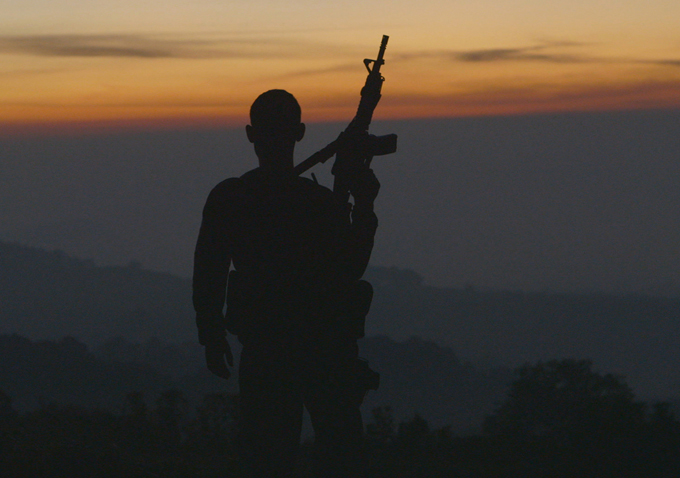 Director Matthew Heineman’s first feature documentary (co-directed with Susan Froemke) was the incendiary and illuminating health care reform piece “Escape Fire.” His second feature “Cartel Land,” solo-directed this time, focuses on a much different issue and takes a more action-oriented, on-the-ground approach, resulting in a film that is more fiery than the first. With unprecedented access to vigilante groups both north and south of the U.S./Mexico border, the film captures searing footage from the front lines of the narco wars, and provides a new perspective on the issue.
Director Matthew Heineman’s first feature documentary (co-directed with Susan Froemke) was the incendiary and illuminating health care reform piece “Escape Fire.” His second feature “Cartel Land,” solo-directed this time, focuses on a much different issue and takes a more action-oriented, on-the-ground approach, resulting in a film that is more fiery than the first. With unprecedented access to vigilante groups both north and south of the U.S./Mexico border, the film captures searing footage from the front lines of the narco wars, and provides a new perspective on the issue.
The film opens with a sequence that is essentially "Breaking Bad: The Documentary." A team of masked Mexican meth cooks unload their supplies from a truck in the desert in the dead of night and proceed to cook the crystal under the harsh glare of the camera’s spotlight. Their spokesperson is both articulate and contrite, admitting their knowledge of the negative effects of cooking and trafficking drugs, but that they have no choice due to their poverty: “If we were like you, we wouldn’t have to do this,” they say, throwing the moral dilemma back into the face of anyone watching the film who has the privilege to not make such choices. This stark opening sequence then slams into a narco-rap-fuelled credit sequence which signals the tone and tenor for what lies ahead: a chilling, heart-pounding, hell-ride into the front lines of battle in the streets of Michoacán, Mexico, and the wilderness of Southern Arizona.
In Mexico, Heineman embeds with the Autodefensas group, an army of concerned citizens taking up arms against the violence of the Knights Templar cartel. As we see from first-hand accounts and a gut-wrenching funeral for fifteen people, ages three months to sixty years, the Knights Templar are bad, bad guys, and the people welcome the Autodefensas happily as their protectors and bearers of vengeance. The group is led by the charismatic “El Doctor,” Dr. Jose Manuel Mireles Valverde, who encompasses a strange duality as a man who is able to both lovingly care for his young patients while also ordering the murder of a captured Templar member. At first presented as a grassroots hero, his complications are gradually revealed.
The footage that Heineman captures (much of it shot himself or by cinematographer Matt Porwoll) while riding along with the Autodefensas is shocking. Gun battles erupt suddenly in small town streets, suspected cartel members are interrogated and tortured, and the whole chaotic, confusing, and hysterical process is lensed clearly and objectively. Even when the camera has to pull focus or reorient itself, it lends a true on-the-ground point of view that puts the viewer directly into the madness. The Autodefensas look and act so much like the cartels, using their tactics against them, that it’s hard to distinguish between the two. It slowly becomes clear that there’s significant overlap.
In the U.S., Heineman follows along with “Nailer,” an American vet who has taken up the task of patrolling the border since losing his construction job in the financial crisis of 2008 and noticing how many undocumented immigrants were getting under-the-table construction work. A man whose hard life shows on his face, Nailer stalks cartel scouts in the scrubby Arizona hills, and feels that anything he can accomplish will put a dent in their operations. The camera roams the hills along with him at eye level, in the mix as much as it is in Mexico, but things are decidedly less dramatic there, despite Nailer’s thorough tactical preparation. Nailer and Mireles are interesting in contrast to each other: Mireles is a popular local figure who gives speeches in every town and sees real, intense action, while Nailer lives on the fringes of society, surrounded only by the select few who join his movement. While both sides have clear motives — to protect themselves when the government can’t or won’t, and to bully the bullies back — the consequences of personal weakness and inevitable corruption muddy the moral and ethical waters.
There are times when “Cartel Land” feels chaotic or confusing, simply because the situations in which the film is embedded are chaotic and confusing. It offers up no easy answers or clear calls to action, just a first-person account of these situations that rule the news and the hand of policy-makers It provides a deeply humanizing element to this incredibly difficult situation. Aesthetically, it is a vibrant, electrifying work, with stunning visuals and a sure hand over layers of complicated audio. Heineman, in placing himself in such danger, has managed to create a remarkable and distinctive film that takes on a difficult issue that cannot be so conveniently remedied or ignored. [A-]
This is a reprint of our review from the 2015 Sundance Film Festival.

